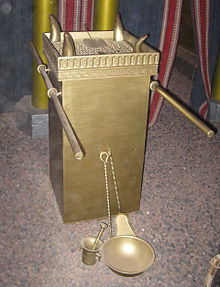Smoke offering
An incense is a form of the victim with a slow combustion fragrant substances to worship purposes, a use that to the early stages of the culture reaches back.
In ancient times it seems to have been the Semitic peoples in particular who performed the smoke offering with great pomp. According to Herodotus , the Chaldeans annually burned incense worth 1,000 talents of silver for the festival of Bel in Babylon , and Plutarch tells of the three times incense offering which the Egyptians offered to the sun in the morning, at noon and in the evening .
With the Hebrews the smoke offering was highly regarded; in the Bible we find the most precise prescriptions regarding its composition and ceremonial. Each priest had his own smoke pan, and in front of the curtain of the tent ( mishkan ) stood the large, gold-coated smoke altar on which spices were burned in the morning and in the evening .
The Greeks learned to use frankincense , as Pliny the Elder reports, only after the Trojan War ; but soon the consumption of it became a lavish luxury , and when Alexander the Great had conquered the north end of the Incense Route , for the first time since the beginning of the war, he sent a shipload of incense home to be sacrificed again.
With the Romans , the waste of incense degenerated even further, as for example Nero is said to have sacrificed more incense at the funeral of his wife Poppea , according to Pliny, than Arabia could deliver in a whole year. With the great consumption, the main components of the incense, the gum resins frankincense, myrrh and balsam , became three precious objects of trade, some of which were weighed in gold . In Pliny’s time, for example, one had to pay the pound of frankincense with six gold denarii (about 6 ducats), which also makes the biblical story that the kings of the East brought the newborn Messiah the greatest treasures of gold, myrrh and frankincense.
The Christians initially regarded the smoke offering as pagan ; but already in the course of the fourth century the incense also penetrated the Christian liturgy with other pagan customs , and it was only forbidden to donate this rite to the imperial statues according to Roman custom. However did not live the altar of incense in ancient form more, and the place of the censer of Jews joined the Inzens . The Eucharistic gifts , all symbols of Christ - i.e. altar , Easter candle , cross, gospel book , crib, the celebrants and the congregation, possibly reliquaries and portraits of saints - are honored with incense .
Literature (not consulted)
- Hans von Fritze: The smoke offerings among the Greeks. Mayer & Müller, Berlin 1894.
- Fred S. Naiden: Smoke signals for the gods. Ancient Greek sacrifice from the archaic through Roman. OUP, Oxford 2013, ISBN 978-0-1902-3271-9 .
- Wolfgang Zwickel : Incense cult and smoking devices. Exegetical and archaeological studies on the incense offering in the Old Testament (= Orbis biblicus et orientalis; Vol. 97). Universitas-Verlag, Freiburg / CH 1990, ISBN 3-7278-0671-0 (also dissertation, University of Kiel 1989).
- Erika Simon , Haiganuch Sarian: Smoke Offering . In: Jean-Charles Balty (Ed.): Thesaurus Cultus et Rituum Antiquorum . Vol. 1: Processions, Sacrifices, Libations, Fumigations, Dedications. Getty Publications, Los Angeles 2004, ISBN 0-89236-788-1 , pp. 255-268.

